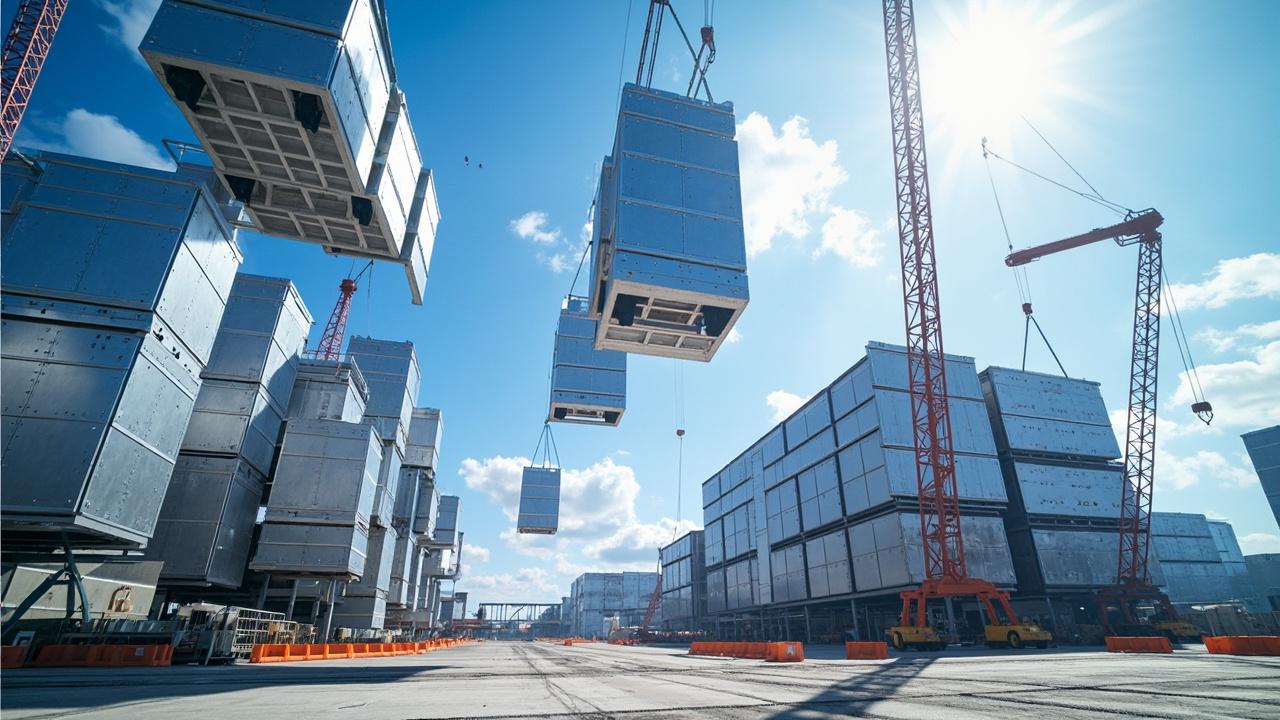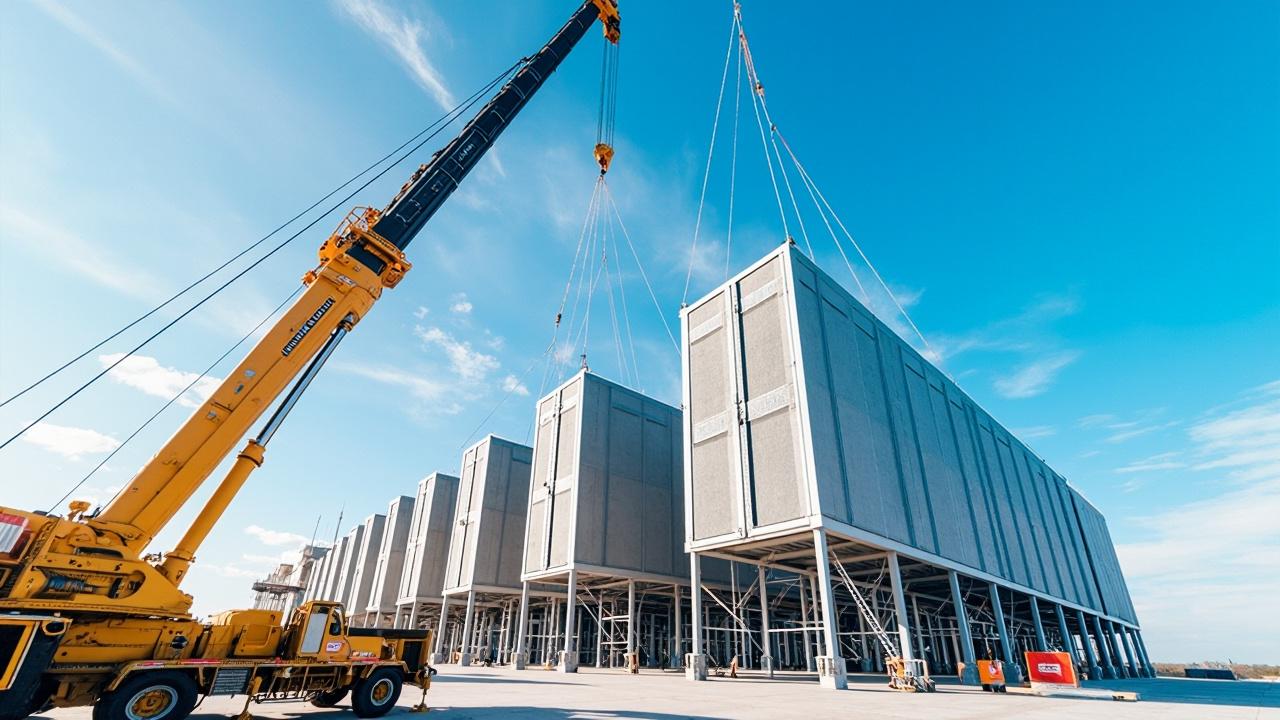Introduction
Data centers are the backbone of the modern digital world, and the demand for increased capacity is exploding. Experts predict continued exponential growth, creating immense pressure to build faster and larger than ever before. But constructing massive 100MW data centers from scratch presents a unique set of challenges. These “big bang” projects are inherently complex, risky, and require significant upfront investment.
The traditional approach to building these large-scale facilities often involves years of planning, extensive construction, and massive capital expenditure before a single server can be powered on. This can lead to over-provisioning, wasted resources, and a struggle to adapt to rapidly changing technology. There’s a smarter, more agile solution: building your next 100MW data center with a modular approach.
This blog post explores the benefits and strategies for building your next 100MW data center using a modular, phased approach. Discover how a modular data center design enables rapid deployment of new capacity as needed, optimizes capital expenditure, reduces risk, and improves overall efficiency. Learn how to strategically plan for incremental growth, incorporate the latest technologies, and ultimately, achieve sustainable data center expansion.
Understanding the Traditional Big Bang Data Center Build
The traditional approach to data center construction often resembles a “big bang” – a massive, upfront investment intended to deliver the full 100MW capacity from day one. This involves constructing the entire facility, installing all the necessary infrastructure, and provisioning for anticipated future needs, all before a single server is even racked. While seemingly efficient on paper, this method is fraught with risks and inefficiencies that can significantly impact project timelines, budgets, and overall business agility.
One of the most significant drawbacks of the big bang approach is the immense upfront capital expenditure required. Companies must secure substantial funding to cover the costs of land acquisition, construction, equipment procurement, and installation, all before generating any revenue from the data center. This can strain financial resources and limit investment in other critical areas of the business.
Moreover, these projects often suffer from long lead times and construction delays, impacted by factors ranging from supply chain disruptions to regulatory hurdles. These delays can push back revenue generation and erode competitive advantage.
Another key issue is the inherent risk of over-provisioning. Predicting future capacity needs with absolute accuracy is virtually impossible. Companies often overestimate demand, leading to wasted resources and underutilized infrastructure. This unused capacity still incurs costs related to power, cooling, and maintenance, significantly impacting operational efficiency. Furthermore, the rapid pace of technological change presents a major challenge.
A data center designed and built using the big bang approach may become obsolete before it even reaches full capacity, as newer, more efficient technologies emerge. In contrast, a modular data center allows for the adoption of newer technologies as the demand requires. Finally, managing these large-scale projects is incredibly complex, requiring specialized expertise in construction, engineering, and project management. The sheer scale of the undertaking increases the likelihood of errors, cost overruns, and communication breakdowns.
The Power of Modular
The traditional “big bang” approach to data center construction is rapidly becoming a relic of the past. The escalating demands for computing power, coupled with the need for agility and cost-effectiveness, have paved the way for a revolutionary paradigm shift: the rise of modular data centers.
This approach involves constructing data centers in smaller, independent units, which can then be combined and scaled to meet specific needs. This block-by-block methodology offers a multitude of advantages over the monolithic, all-at-once construction model, creating a far more adaptable and efficient solution for modern data center infrastructure.
Core Principles of Modular Design
At the heart of modular data center design are three fundamental principles: standardization, scalability, and prefabrication. Standardization involves using consistent designs, components, and interfaces across all modules. This simplifies deployment, maintenance, and upgrades, and ensures interoperability.
Scalability is the ability to easily add or remove modules as needed, allowing data centers to grow in tandem with business demands. Prefabrication entails constructing modules off-site in controlled factory environments, reducing construction time, improving quality control, and minimizing on-site disruption. The synergy of these three principles creates a powerful engine for data center innovation and optimization.
Diverse Modular Solutions
The beauty of the modular approach lies in its versatility. A variety of module types cater to diverse needs and environments. Containerized data centers, often deployed outdoors, offer rapid deployment and portability. Skid-mounted systems provide a flexible and scalable solution for indoor environments, while brick-and-mortar extensions allow for seamless integration with existing facilities.
For instance, a company might start with a containerized solution to quickly address immediate capacity needs, then gradually expand with skid-mounted systems within their existing building. Each type brings unique advantages to the table, allowing organizations to tailor their data center infrastructure to their specific requirements. The standardization of the modular data center components also means that you can interchange parts for efficient maintenance.
Real-World Success Stories
The shift towards modular construction is not merely theoretical. Numerous organizations have successfully deployed modular data centers to great effect. Cloud providers are increasingly adopting modular designs to rapidly expand their infrastructure and meet the ever-growing demands of their customers. Enterprises are leveraging modular solutions to enhance agility, reduce costs, and improve energy efficiency. These real-world examples demonstrate the viability and tangible benefits of embracing the modular approach. A modular data center can be a game changer.
Key Benefits of Phased Deployment
Phased deployment offers a compelling alternative to the traditional “big bang” approach, primarily by enhancing agility. In today’s rapidly evolving digital landscape, businesses need to be able to respond quickly to changing market demands and technological advancements. A phased approach allows data center operators to deploy new capacity as needed, rather than being stuck with a massive, pre-built facility that may not fully align with current requirements.
This adaptability is crucial for remaining competitive and avoiding costly over-provisioning. For example, a cloud provider experiencing a surge in demand for a specific service can quickly deploy an additional module to meet that need, without having to wait for a lengthy construction process. This responsiveness translates directly into improved customer satisfaction and increased revenue opportunities.
Beyond agility, a modular strategy unlocks significant cost savings throughout the data center lifecycle. The initial capital expenditure is considerably lower compared to building a massive data center upfront. This allows organizations to allocate resources more strategically and reduce the financial risk associated with large-scale projects.
Furthermore, operational expenses, such as cooling and power, can be optimized by only running the capacity that is currently needed. For example, a partially populated data center will consume less energy than a fully built one, leading to substantial savings over time. The ability to implement the latest energy-efficient technologies and designs in each new module further enhances these savings.
Finally, adopting a phased deployment reduces overall project risk. The initial investment is lower, minimizing the potential financial impact of unforeseen circumstances. Construction delays, a common occurrence in large-scale projects, are less disruptive when building in smaller increments. A failure within one module is less likely to cause widespread downtime, as the impact is contained to that specific section.

This inherent resilience improves the overall stability and reliability of the data center. The ability to thoroughly test and validate each module before deployment further reduces the risk of encountering critical issues later on. Because of this, the modular data center methodology has become increasingly popular.
| Benefit | Description |
|---|---|
| Agility | Rapid deployment of new capacity as needed, responding to market demands and technological advancements. |
| Cost Savings | Optimized capital expenditure, reduced operational expenses (e.g. cooling, power), and the ability to implement the latest energy-efficient technologies. |
| Reduced Risk | Lower initial investment, minimized downtime during expansion, and improved overall stability and reliability. |
Designing Your Modular Data Center
Strategic planning is paramount when embarking on a modular data center build. Unlike traditional builds where the entire facility is constructed at once, a modular approach requires a clear vision of the final state, even while implementing in phases. Think of it like designing a city: you need a master plan for roads, utilities, and zoning even as you build the first neighborhood. This foresight ensures seamless integration and avoids costly re-engineering down the line.
Site Selection: Location, Location, Scalability
Choosing the right location takes on added significance with modular builds. Beyond the usual considerations like power availability, connectivity, and natural disaster risks, you must also consider the site’s ability to accommodate future expansion. Can the site physically handle the planned 100MW footprint, plus any potential additions beyond that?
Is there sufficient space for access roads, parking, and utilities for each phase of the build? Moreover, consider local zoning regulations and permitting processes, as these can significantly impact the timeline for each expansion phase. A seemingly ideal location might be rendered impractical if future expansions are hampered by restrictive zoning laws.
Master Planning: The Blueprint for 100MW and Beyond
A comprehensive master plan is the cornerstone of a successful modular data center deployment. This plan should detail the layout of each module, the planned power and cooling infrastructure, and the network topology for the entire 100MW facility. It should also outline the timeline for each phase of construction, accounting for potential delays and contingencies.
Importantly, the master plan must be flexible enough to adapt to changing technology and business needs. For example, the initial design might incorporate traditional air cooling, but the plan should allow for the easy integration of liquid cooling in later phases as rack densities increase. A well-defined master plan provides a roadmap for incremental growth while ensuring that each module seamlessly integrates into the overall data center ecosystem.
Future-Proofing: Adapting to the Unpredictable
Technology evolves at a breakneck pace, and data centers must be designed with future adaptability in mind. When planning your modular data center, consider how easily you can upgrade components or implement new technologies without disrupting existing operations. For instance, design your power and cooling infrastructure with excess capacity to accommodate future increases in rack density.
Consider a modular data center approach that will allow you to easily swap out older equipment for newer, more efficient models. This proactive approach ensures that your data center remains competitive and avoids obsolescence. By carefully considering these factors, you can build a modular data center that is not only scalable and cost-effective but also future-proof.
Technology Considerations
In a modular environment, power solutions must be equally flexible and scalable. Traditional, monolithic power systems don’t align well with the incremental growth model. Instead, consider modular generators, uninterruptible power supplies (UPS), and power distribution units (PDUs) that can be added as needed.
This approach allows for right-sizing power infrastructure to current demand, avoiding the capital expenditure and wasted energy associated with over-provisioning. Furthermore, smart grid integration and renewable energy sources can be incorporated on a module-by-module basis, contributing to a more sustainable and cost-effective operation. A well-designed power architecture will ensure business continuity and scalability as the data center grows.
Cooling technologies also need to adapt to the modular paradigm. Traditional, centralized cooling systems are often inefficient in partially populated data centers. Therefore, direct-to-chip liquid cooling or even rear door heat exchangers offer a targeted cooling solution for high-density racks.
Moreover, containment strategies like hot aisle/cold aisle arrangements become even more critical in a modular design to maximize cooling efficiency. Free cooling solutions, where ambient air or water is used to cool the data center, can also be deployed in a modular way, taking advantage of geographic location and seasonal temperature variations.
Connectivity and network infrastructure are paramount. A modular approach demands robust, scalable, and easily configurable network solutions. Pre-terminated cabling, modular switches, and software-defined networking (SDN) can all facilitate rapid deployment and reconfiguration as new modules are added. A critical, often overlooked, aspect is the implementation of comprehensive monitoring and management systems.
These systems must provide real-time visibility into power consumption, cooling performance, and network traffic across all modules. Smart monitoring enables proactive identification of potential issues, optimization of resource utilization, and ultimately, improved overall efficiency and reliability. Integrating a robust monitoring system can streamline operations within the modular data center. This also enhances capacity planning and resource allocation.
| Technology | Considerations for Modular Data Centers |
|---|---|
| Power | Modular generators, UPS systems, PDUs, Smart grid integration, Renewable energy sources |
| Cooling | Direct-to-chip liquid cooling, Rear door heat exchangers, Containment strategies, Free cooling |
| Connectivity | Pre-terminated cabling, Modular switches, Software-defined networking (SDN) |
| Monitoring | Real-time visibility, Proactive issue identification, Resource optimization |
Case Study
Let’s delve into a compelling example of a company that expertly navigated the complexities of constructing a 100MW data center, leveraging the advantages of a modular deployment strategy. This real-world success story underscores the practical benefits and strategic foresight inherent in adopting a phased, building-block approach. Their journey provides invaluable insights for organizations contemplating similar large-scale data center projects.
This particular company, a global cloud service provider, initially projected a need for substantial computing capacity to meet escalating customer demands. Traditional “big bang” construction seemed daunting, fraught with financial risks and potential delays. Instead, they opted for a phased deployment, constructing several independent sections within a *modular data center*, adding more as needed.
This allowed them to begin generating revenue much sooner than if they had waited for the completion of an entire facility. Their modular approach also allowed them to select different technologies at different phases.
Here are a few challenges that the company faced and how they overcame them:
- Standardization: Establishing consistent specifications for each module to ensure seamless integration and interoperability. This was achieved through rigorous testing and adherence to industry standards.
- Security: Implementing robust security measures across all modules, including physical security, network segmentation, and access controls.
- Integration: Ensuring that the various modules could communicate and operate effectively as a single, cohesive data center. This required careful planning and coordination during the design and deployment phases.
The benefits were substantial. They realized a 20% reduction in upfront capital expenditure and slashed their time-to-market by 30%. They gained the flexibility to incorporate advanced cooling technologies in later modules, improving overall energy efficiency. Moreover, the modular approach greatly reduced the risk of stranded capacity, as they could precisely match capacity to actual customer demand.

Overcoming Challenges and Maximizing ROI With a Modular Data Center
One of the primary concerns we hear revolves around security. Some perceive that a distributed, modular approach might introduce vulnerabilities compared to a monolithic structure. However, modern modular designs prioritize security at every level.
Each module can be equipped with its own dedicated security measures, including physical access controls, fire suppression systems, and advanced monitoring capabilities. Furthermore, the standardized nature of the modules allows for consistent implementation of security protocols across the entire data center, reducing the risk of human error and overlooked vulnerabilities.
Integration is another key challenge. How do you ensure seamless interoperability between different modules, especially if they are sourced from different vendors or utilize varying technologies? The answer lies in adhering to open standards and robust APIs. By prioritizing interoperability, you can create a flexible and adaptable environment that can easily accommodate new technologies and future expansion. A well-defined integration strategy is paramount, involving thorough testing and validation to ensure smooth operation across all modules.
To truly maximize the return on investment (ROI) of your modular data center, a strategic partnership with an experienced provider is crucial. These experts can guide you through the entire process, from initial planning and design to deployment, integration, and ongoing maintenance. They possess the knowledge and resources to navigate the complexities of modular construction and help you optimize your design for performance, efficiency, and scalability.
Furthermore, they can provide valuable insights into the latest industry trends and best practices, ensuring that your data center remains at the forefront of innovation. By addressing these common concerns and implementing best practices, organizations can unlock the full potential of the modular data center approach and achieve significant cost savings, improved agility, and enhanced security.
The Future of Data Centers
The data center landscape is rapidly evolving, driven by the ever-increasing demand for compute power, storage, and network bandwidth. As businesses generate and process massive amounts of data, the need for agile, scalable, and sustainable data center solutions becomes paramount. The traditional “big bang” approach to data center construction is proving increasingly inadequate to meet these demands.
Instead, the industry is witnessing a paradigm shift towards modularity, a design philosophy that promises to revolutionize how data centers are built, managed, and scaled. This move isn’t just about keeping up; it’s about getting ahead, especially when considering long-term operational costs and environmental impact.
Modularity is quickly becoming synonymous with sustainability in the data center world. Traditional builds often result in over-provisioning, meaning significant energy is wasted cooling and powering unused capacity. A modular approach allows for a “just-in-time” deployment model, adding capacity only when it’s needed.
This minimizes waste and optimizes resource utilization, contributing to a smaller carbon footprint. Furthermore, modular designs facilitate the integration of advanced cooling technologies like free cooling and liquid cooling, which can significantly reduce energy consumption compared to conventional air-cooled systems. In essence, the modular data center is not just a flexible solution, but a more responsible one, aligning business growth with environmental stewardship.
Looking ahead, expect to see even greater advancements in modular data center technology. Innovations in prefabricated components, power distribution, and cooling systems will further enhance efficiency and reduce construction timelines. We can also anticipate a greater emphasis on intelligent monitoring and management systems, leveraging AI and machine learning to optimize resource allocation and predict potential issues before they impact operations.
Consider the following trends driving the adoption of modularity:
Conclusion
The journey to a 100MW data center doesn’t have to be a daunting, all-or-nothing endeavor. As we’ve explored, the modular approach offers a far more agile, cost-effective, and ultimately less risky path to achieving substantial data center capacity.
By embracing a phased deployment strategy, organizations can avoid the pitfalls of traditional “big bang” builds, optimizing capital expenditure, reducing lead times, and minimizing the risk of over-provisioning. This methodology allows for a dynamic response to evolving market demands and technological advancements, ensuring your infrastructure remains both cutting-edge and aligned with actual needs.
The advantages extend beyond mere financial considerations. A modular data center design promotes scalability and flexibility, enabling businesses to seamlessly integrate new technologies and adapt to shifting workloads. This future-proof approach not only enhances operational efficiency but also contributes to a more sustainable data center ecosystem.
By implementing energy-efficient cooling and power solutions within each module, organizations can significantly reduce their environmental footprint and contribute to a greener future. Furthermore, the inherent standardization of modular designs simplifies management and maintenance, streamlining operations and minimizing downtime.
Ultimately, the key to success lies in meticulous planning and strategic partnerships. Before embarking on your modular journey, it’s crucial to develop a comprehensive master plan that outlines the long-term vision for your 100MW facility. This plan should encompass site selection, infrastructure design, and technology integration, ensuring seamless scalability and optimal performance.
Collaborating with experienced modular data center providers is equally essential. These experts can provide valuable guidance on design, deployment, and ongoing management, helping you navigate the complexities of modular construction and maximize your return on investment. By embracing the modular approach, you’re not just building a data center; you’re building a foundation for future growth, innovation, and sustainable success.
Frequently Asked Questions
What is a modular data center?
A modular data center is a prefabricated, transportable data center designed to be deployed and scaled quickly. It comprises standardized components built offsite in a controlled factory environment and then shipped to the desired location for assembly. These units are self-contained and can include power, cooling, and security infrastructure, offering a flexible and scalable approach to data center deployment.
What are the key benefits of using a modular data center?
The core benefits of leveraging modular data centers include faster deployment times and reduced capital expenditure. Their prefabricated nature enables quicker setup compared to traditional construction. Scalability is another significant advantage, allowing organizations to easily add capacity as needed. Furthermore, modular designs can offer improved energy efficiency and potentially lower operational costs.
What are the different types of modular data center solutions available?
Modular data center solutions are available in various configurations, including containerized and skidded designs. Containerized solutions are typically housed within shipping containers, offering portability. Skidded solutions are built on a metal framework for easy transport and placement. Some solutions offer all-in-one integration, while others focus on specific components like power or cooling modules that can be integrated.
How does a modular data center compare to a traditional data center in terms of cost?
Modular data centers often provide cost advantages compared to traditional data centers, particularly in upfront capital expenditures. The prefabricated approach and faster deployment can reduce construction costs and time-to-market. While operational expenses depend on specific design and usage, modular solutions can provide energy efficiency. However, overall cost competitiveness depends on factors like scale, customization, and location requirements.
What is the typical deployment timeline for a modular data center?
Deployment timelines for modular data centers are significantly shorter than traditional builds. Depending on the complexity and scale of the project, a modular data center can typically be deployed in a matter of weeks or months.
This rapid deployment is a major advantage, allowing organizations to quickly respond to changing business needs and minimize downtime associated with building and commissioning a traditional data center.




